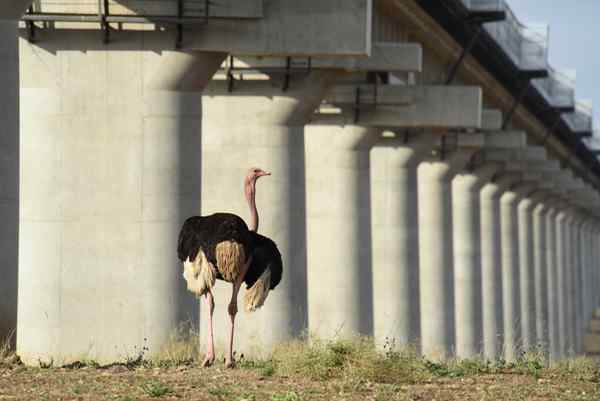Images of climate innovation
Don't stick your head in the sand
This image shows an Ostrich being confronted by the arrival of a new feature within Nairobi National Park - a railway. The Development Corridor Partnership has been researching the wider social and environmental impacts of new transport corridors in Kenya. This new railway has dissected the 'Protected Area' while the route is still be contested through the courts.

The development corridor partnership has been looking at the wider social and environmental impacts of new transport (roads, railways, pipelines, ports) in Kenya and Tanzania. While there are many positives that come from new roads, these developments can result in negative outcomes for nature and people, including loss of land, wildlife and habitats. For example, by creating new barriers to the movement and migration of mammals, such as elephants, new transportation infrastructure can undermine the ability to adapt to future climatic and land use impacts.
One of the critical challenges for new transportation infrastructure is to safeguard the 'spaces for the wildlife' and associated local livelihoods so that better planning and management can sustainably mitigate any adverse effects. This requires relevant historical and current up-to-date social and ecological information that can be used to explore future impacts. Such information is presently lacking in many regions earmarked for rapidly expanding road and rail networks. Given the government's enthusiasm for large 'infrastructure for development' construction projects, and the speed of infrastructure development that outpaces social and ecological ability to adjust, we have to try and get ahead of the construction to chart how this can be done better.
Work at the University of York is combining historical and environmental data with a participatory modelling approach (KESHO) to investigate interactions between changing human population, environments, infrastructure and development at a landscape scale in the recent past and the near future. Our results show the wider social, environmental, economic and social impacts of the very rapid developments and to see how they can be used to achieve sustainable development goals and the wider development agenda of the African Union. We aim to ensure new roads and railways can truly function as development corridors that support economic development and safe guard nature and societies, now and into the future.
Entrant: Robert Marchant , University of York
Copyright: Robert Marchant
Funding: UKRI through GCRF
Collaborators: Jessica Thorn, Tobias Nyumba, Lucy Waruingi (University of York).